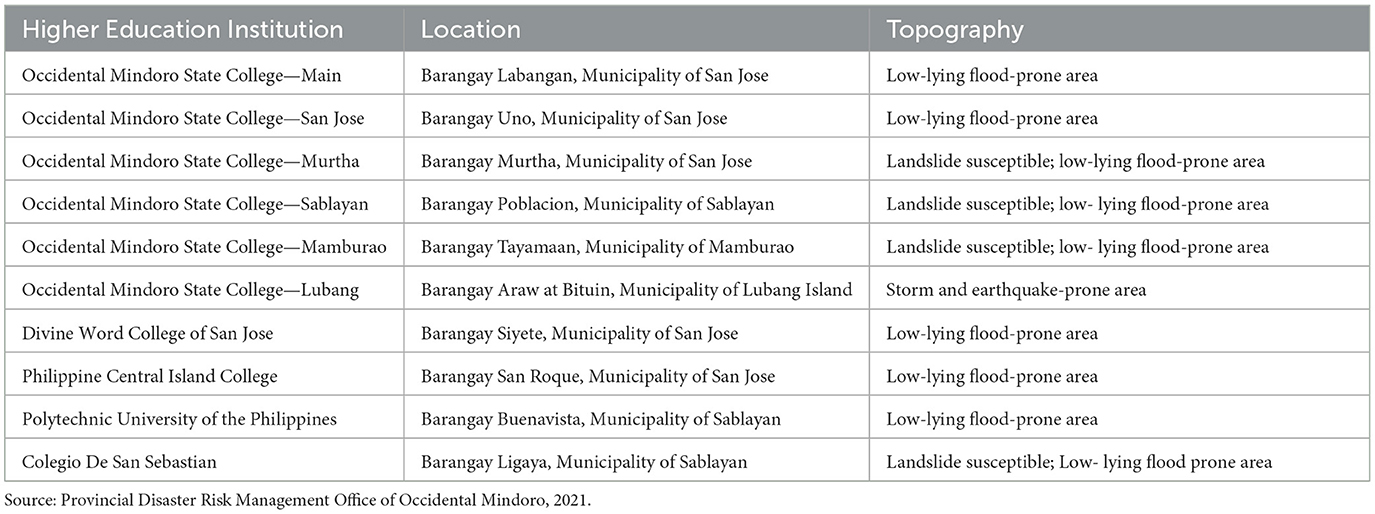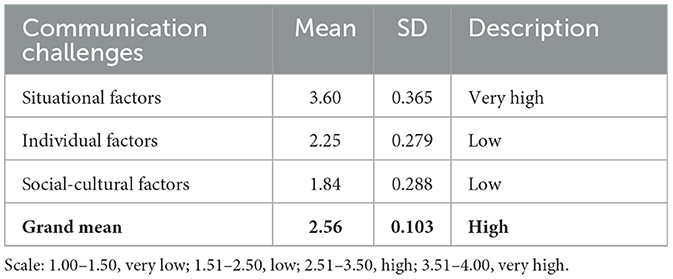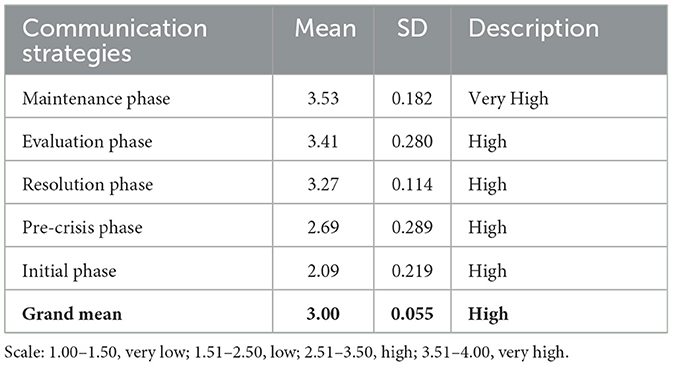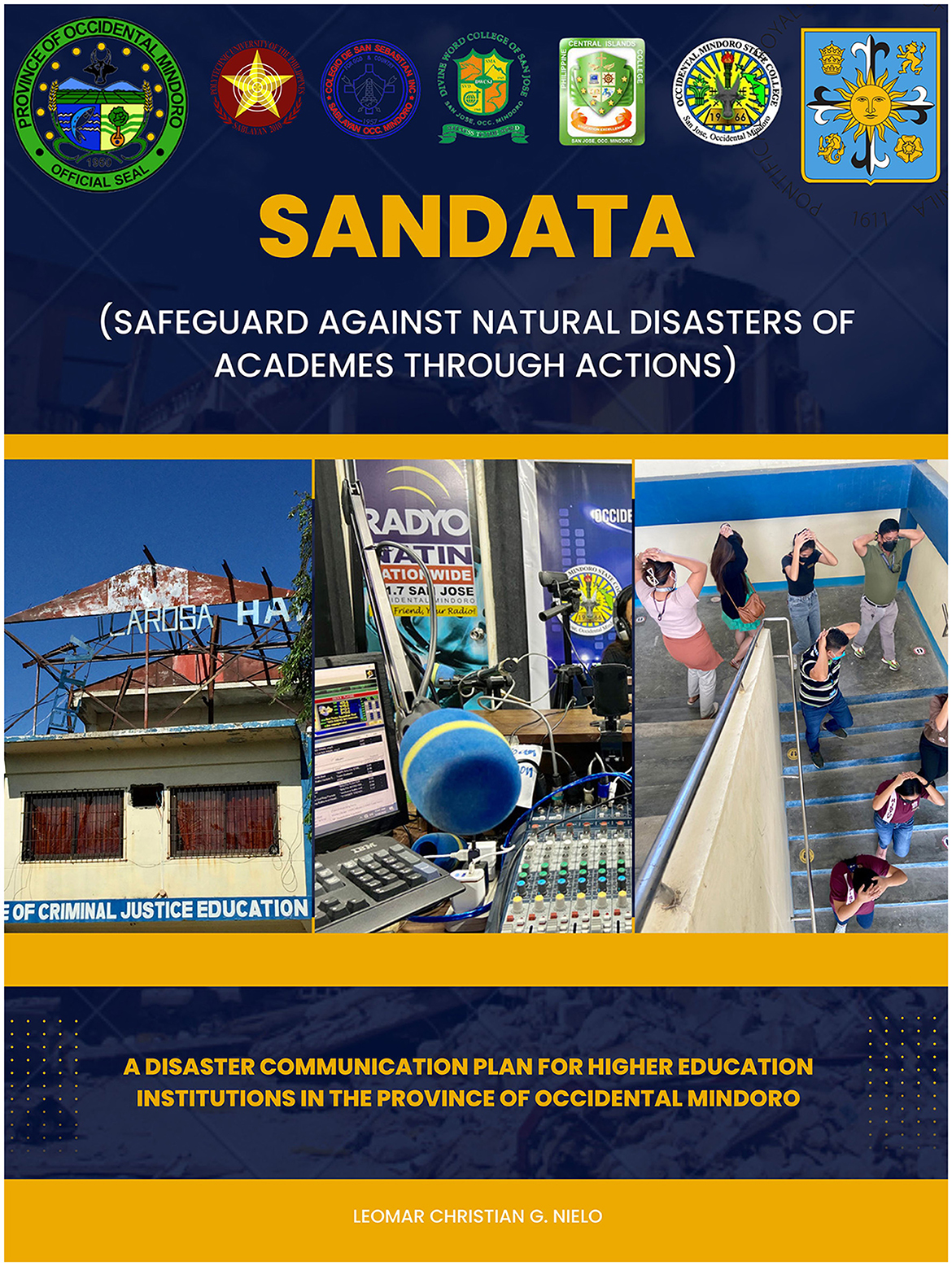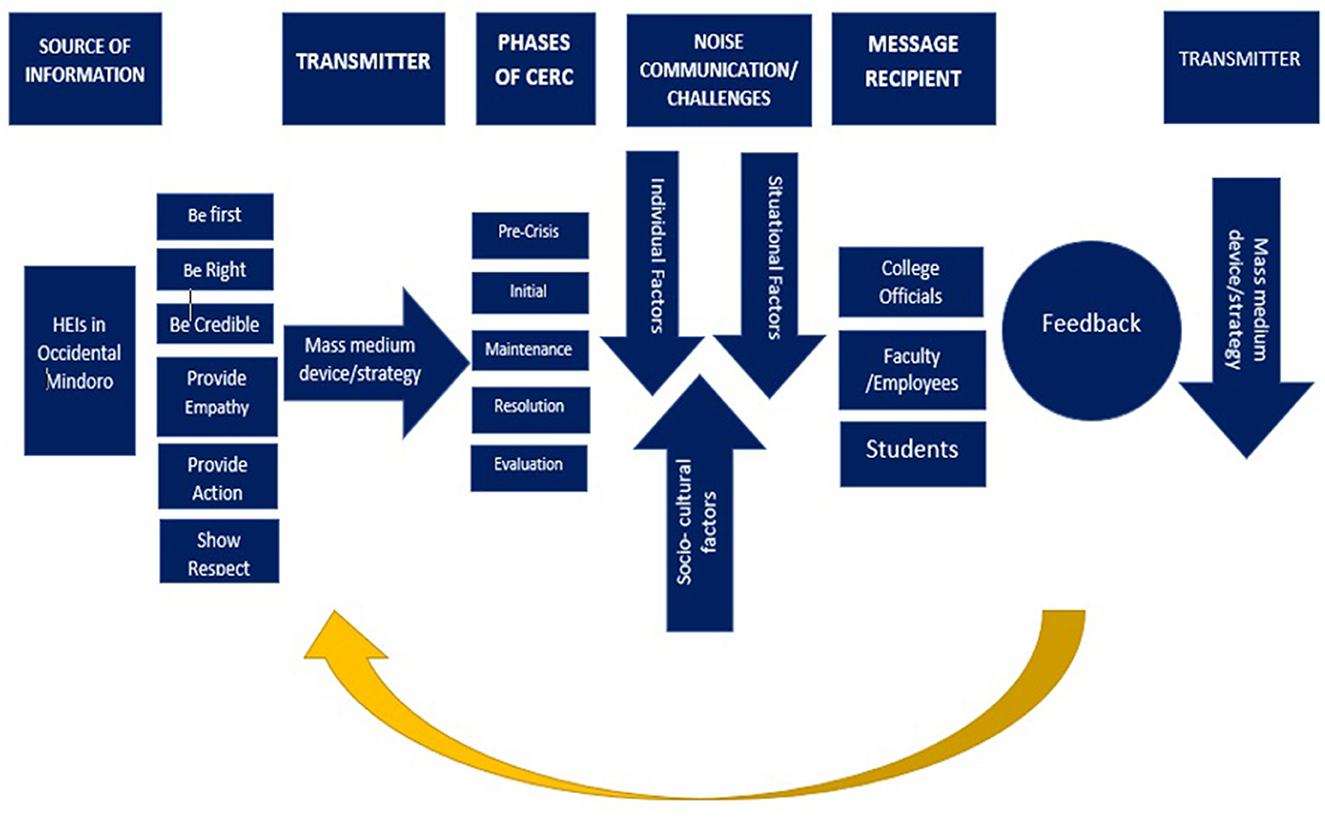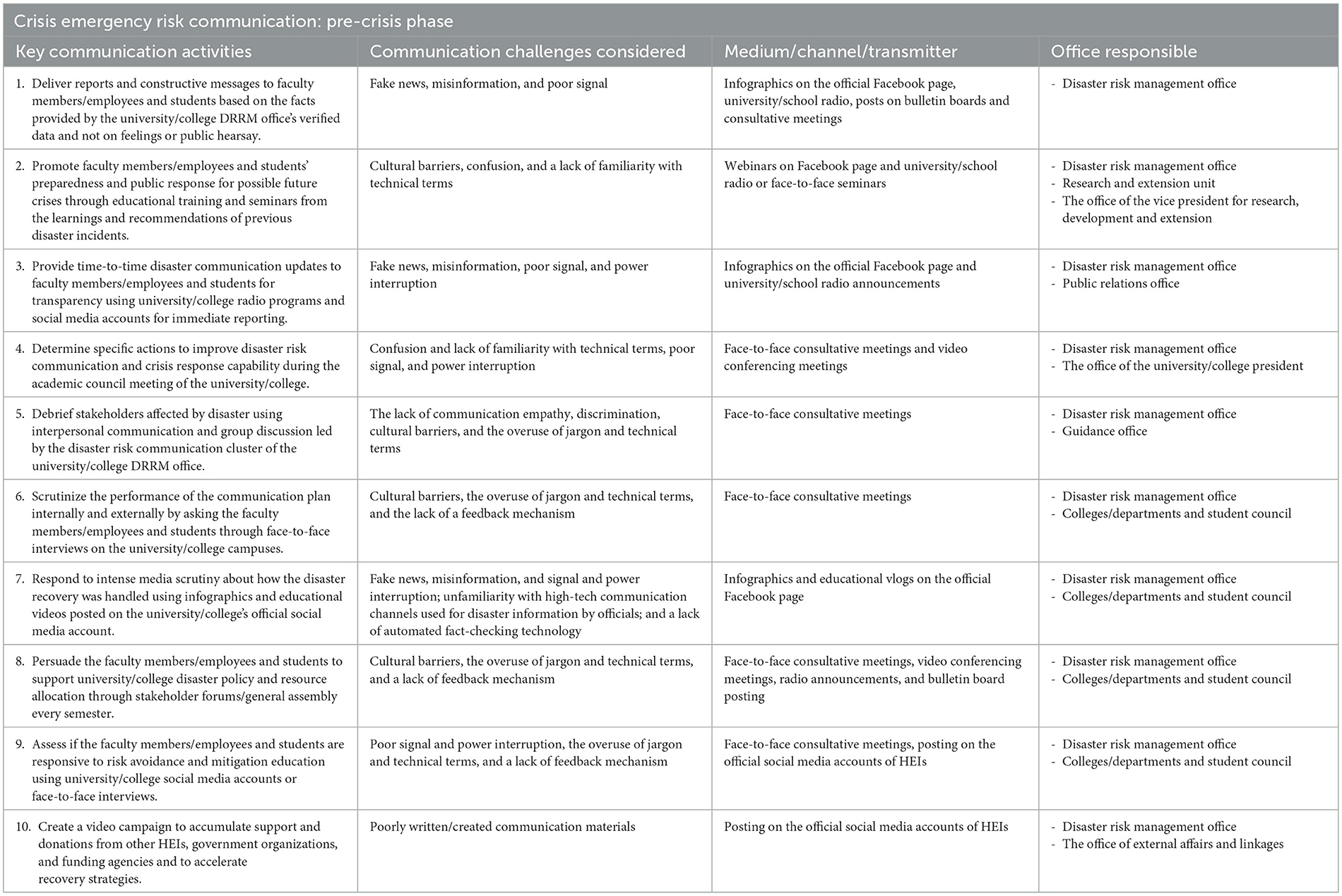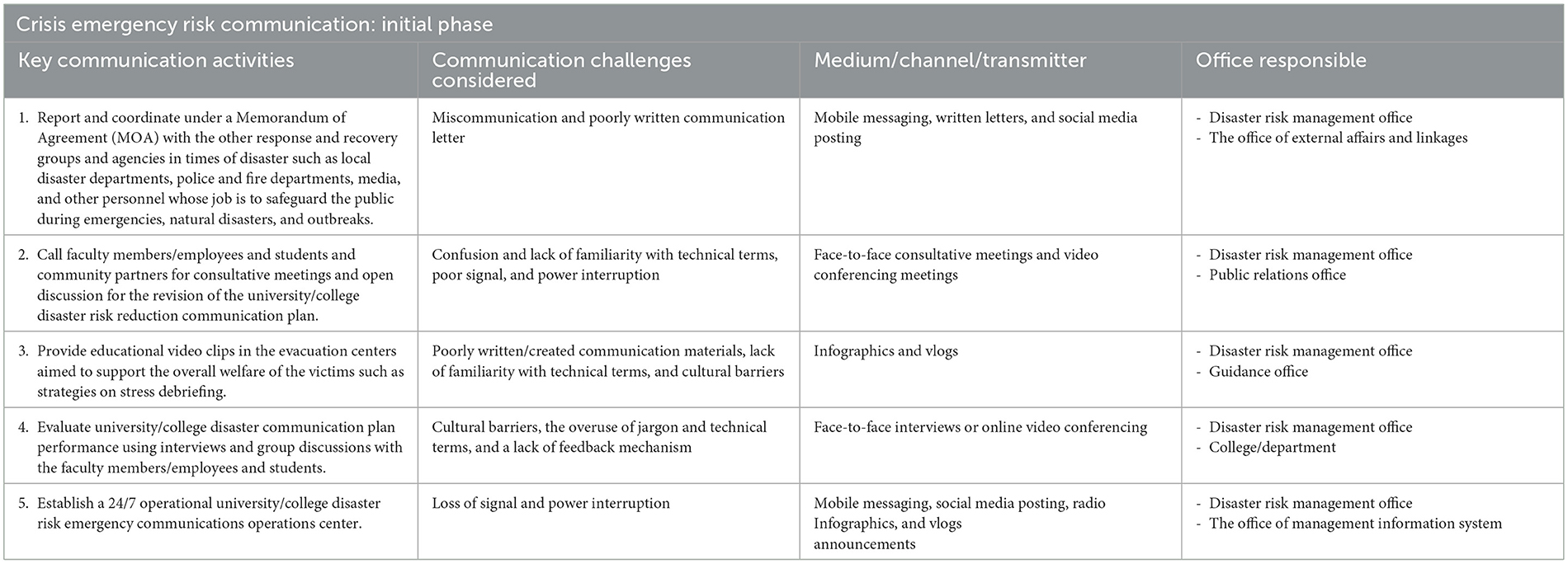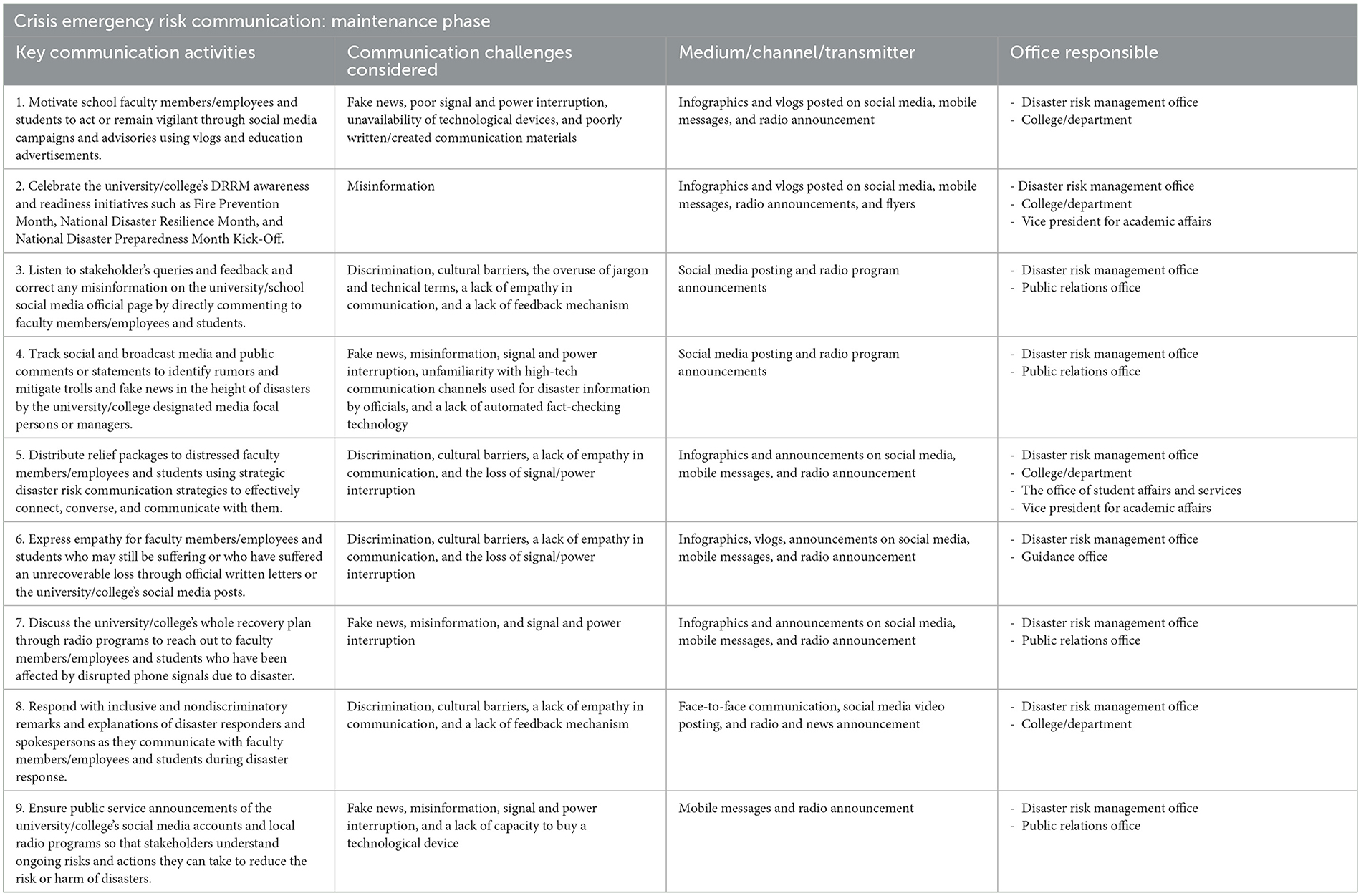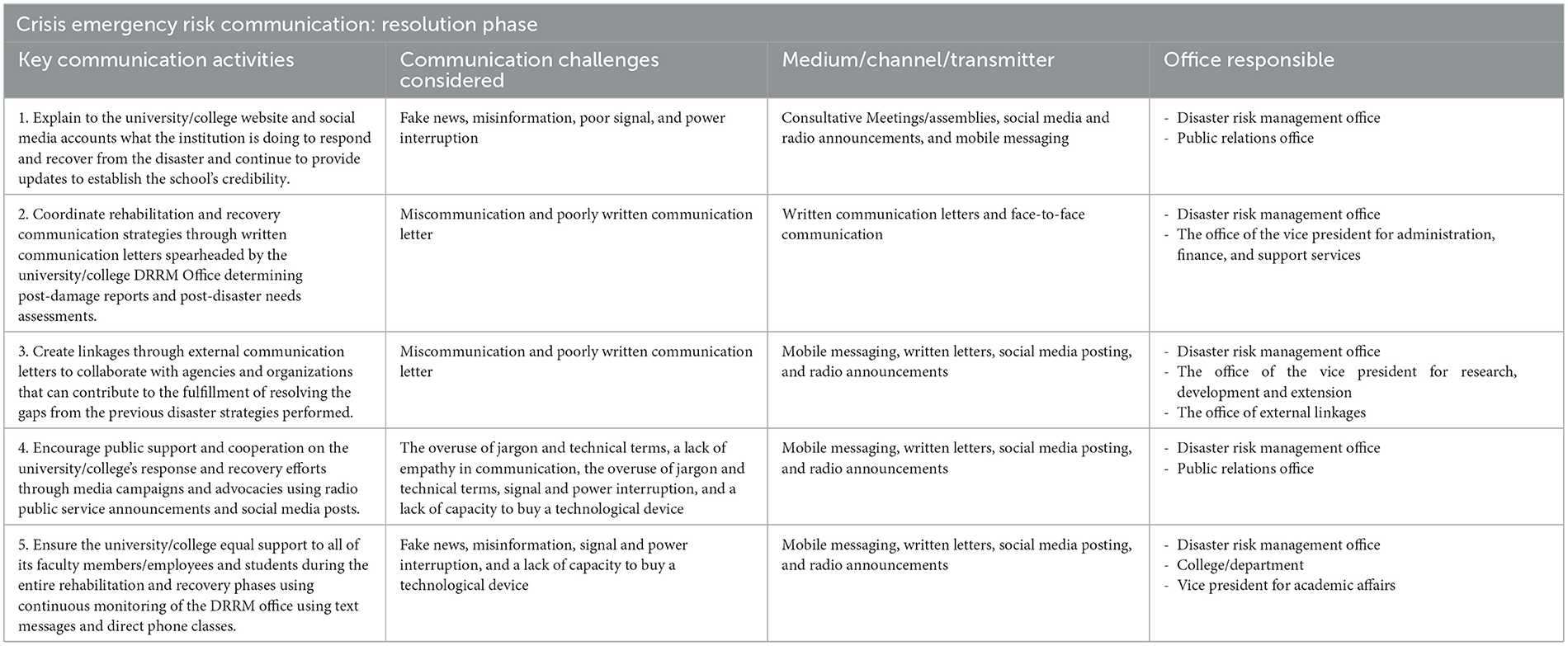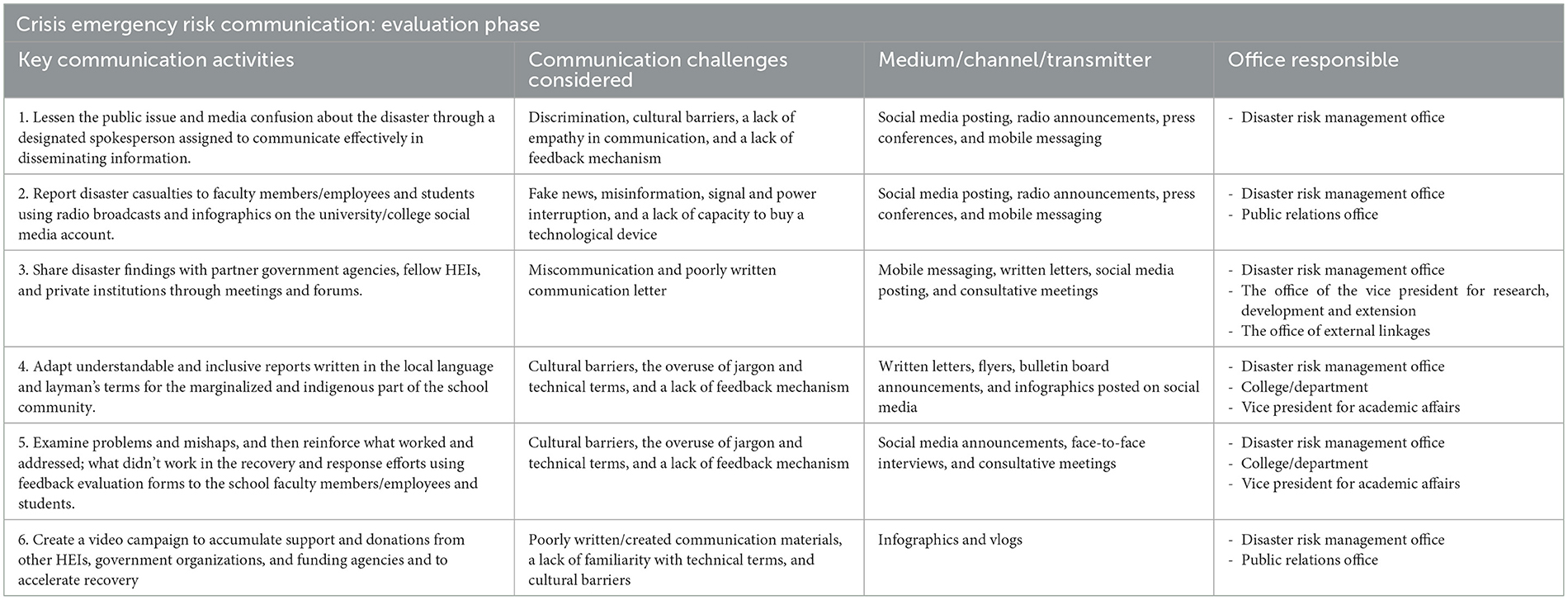- The Graduate School, University of Santo Tomas, Manila, Philippines
Natural disasters, as they impede development and exacerbate poverty, have been the foremost concern of developing countries such as the Philippines. With this, the Philippine Disaster Risk Reduction Management Act (RA 10121) highlights the role of Higher Education Institutions (HEIs) in disaster resiliency and requires the incorporation of disaster communication in their institutions. Since disaster communication is considered to be one of the most valuable assets during disasters, academic institutions are provided visibility, credibility, and concrete direction to address chaos and confusion and to secure the safety of their stakeholders. The study created Safeguard Against Natural Disasters of Academes Through Actions (SANDATA), a disaster communication plan for HEIs in Occidental Mindoro to provide disaster communication strategies that can be used by them in securing a disaster-resilient academic environment. The output of this study was materialized using factor and thematic analysis and through the 300 respondents assigned for the quantitative data and 30 respondents assigned for the qualitative data. These findings influenced the disaster communication strategies employed by HEIs under the disaster stages of the Crisis Emergency Risk Communication (CERC) Theory, stakeholders' identified communication challenges as experienced by them, and their recommendations for improving the existing strategies of their institutions.
1 Introduction
The nexus between disasters and development interweaves as disasters disrupt development. To illustrate, Shepherd et al. (2016) described disasters as communal risk drivers exacerbating poverty, underdevelopment, and disruption in society. Furthermore, the Academy of Disaster Reduction and Emergency Management (2021) stated that large numbers of deaths and destruction due to weak disaster risk reduction management limit the opportunities to manage risks and strengthen disaster resilience.
As a resolution, the UN Member States adopted the Sendai Framework for Disaster Risk Reduction (SFDRR) 2015–2030 on 18 March 2015, at the Third UN World Conference on Disaster Risk Reduction. SFDRR constituted a global plan for disaster risk reduction and a pivotal strategy for achieving the 2030 Agenda for Sustainable Development (UNISDR, 2015). This laid down cross-cutting strategies across sectors of development reducing the disaster vulnerability of the poor, most especially in developing countries such as the Philippines (Atta-ur and Fang, 2019).
To further strengthen its areas toward international standards of disaster risk reduction, the National Disaster Risk Reduction Management Plan of 2020–2030 (NDRRMP) was devised. It was in accord with the mandate of the Philippine Disaster Reduction and Management Act (RA 10121), which provided a strategic direction for disaster risk reduction management in the country (Bollettino et al., 2018).
The Province of Occidental Mindoro's general topography has been identified as prone to typhoon events and susceptible to flooding (Occidental Mindoro PDDRMO, 2022). As evidence, Bautista (2022) attested that Occidental Mindoro State College (OMSC), for example, was reported to have  12 million in damage from the aftermath of Typhoon Tisoy and Ursula, which devastated the Province of Occidental Mindoro in December 2019. Consequently, among the disaster risk reduction management strategies, the hotline area and support services received the lowest performance remarks from stakeholders. In addition, they identified that information sharing and press release information were the least perceived competency on DRRM measures on HEIs in Region IV-B.
12 million in damage from the aftermath of Typhoon Tisoy and Ursula, which devastated the Province of Occidental Mindoro in December 2019. Consequently, among the disaster risk reduction management strategies, the hotline area and support services received the lowest performance remarks from stakeholders. In addition, they identified that information sharing and press release information were the least perceived competency on DRRM measures on HEIs in Region IV-B.
The consequences of ineffective communication in the forms of confusion, misunderstanding, and false information were observed in three major disasters in the Philippines. For instance, in 2011, the residents of Cagayan De Oro and Iligan were unaware of massive flash floods brought by Typhoon Sendong, thus resulting in thousands of deaths. Within just a year, in 2012, Typhoon Pablo had perished thousands of lives in Mindanao due to unprepared communities and government offices, consequently, failing to follow warnings (Cayamanda and Lopez, 2018). Furthermore, in 2013, Typhoon Yolanda devastated Leyte leaving massive destruction of properties and infrastructures and also causing thousands of deaths. The ineffective communication strategy was identified to be the major drawback. The government and media warnings provided to the community before the landfall were ineffective due to the misunderstanding of the terminology used, that is, “storm surge”, resulting in forecast hesitancy and leading people to ignore and hesitate to evacuate (Neussner, 2014).
In summary, it was evident that Higher Education Institutions in the Province of Occidental Mindoro have been facing tremendous challenges in the execution of disaster communication. With regard to this, with the HEIs' substantial resources, Ahmad (2007) observed that universities and colleges in the Philippines are capable of utilizing education and communication to secure a safe learning environment for its stakeholders, mitigating risks, and improving the disaster resiliency of the community. Furthermore, Hardiyanto and Pulungan (2019) stated that the Philippine Disaster Risk Reduction Management Act (RA 10121) mandates the incorporation of disaster communication as a widely utilized arsenal of disaster risk reduction management by government agencies.
Relatively, the National Disaster Risk Reduction Management Plan of the Philippines recognizes the role of HEIs to identify, prevent, mitigate, and recover from disaster impact using public awareness and effective communication (Alejandro, 2019). Whereas, disaster communication can accelerate the process of relaying important information using the best strategy and medium possible. It covers gathering information about the risks from news or authorities to the community or stakeholders which enables them to act and safeguard or minimize the impact of risks (Boin et al., 2017).
With the intent of strengthening the disaster communication strategies and eventually fostering disaster resilient academic environment in the Province of Occidental Mindoro, this study sought to determine the disaster risk communication strategies of HEIs in the province in the five stages of the Crisis and Emergency Communication Theory, identify communication challenges as experienced by stakeholders, and gather their experiences and recommendations to improve existing strategies of their institutions. The findings gathered were used as a basis to craft a disaster communication plan for HEIs in Occidental Mindoro entitled “Safeguard Against Natural Disasters of Academes Through Actions” or SANDATA as an acronym borrowed from a Tagalog word, which means a tool used as a weapon to defend or protect.
2 Materials and methods
In the following sections, the study objectives, the theoretical framework, the methodology used in the study, the research design, the study subjects and data gathering procedure, and statistical techniques were described.
2.1 Research objectives
This study aimed to propose a disaster communication plan for Higher Education Institutions of the Province of Occidental Mindoro. Specifically, the study has the following study objectives:
1. To determine the communication challenges experienced by stakeholders in Higher Education Institutions during disasters considering the following:
a. Individual factors
b. Socio-structural factors
c. Situational factors.
2. To ascertain how stakeholders of Higher Education Institutions experience communication challenges during disasters as follows:
a. Academic/Administrative Officials
b. Faculty and Employees
c. Students.
3. To identify the strategies that can be determined for disaster communication according to the crisis emergency communication model across stages:
a. pre-crisis
b. initial event
c. maintenance
d. resolution
e. evaluation.
4. To understand how these disaster communication strategies can be further improved according to HEI stakeholders.
5. To discover what communication plan can be generated and proposed for Higher Education Institutions in the Province of Occidental Mindoro based on the study's findings.
2.2 Theoretical framework
This study was anchored in the Theory of Crisis and Emergency Risk Communication (CERC) of Reynolds and Seeger in 2005. Reynolds and Seeger suggested that this five-stage theory was merged for public safety practices and mature areas of risk and crisis communication addressing crisis development and disaster management. It was designed to build capacity for public health safety practitioners and disaster managers. It has been used repeatedly to address disasters and public health crises such as Bird flu, Ebola, uranium exposures, chemical spills, humanitarian emergencies such as the 9/11 bombing and the 2001 Anthrax terrorist attack, and calamities such as typhoons (Thomas et al., 2016).
The Crisis and Emergency Risk Communication model is a tool that will help communicators manage complex events (Veil, 2008) as it is categorized into five stages: pre-crisis, initial event, maintenance, resolution, and evaluation. Each stage provides a broad set of strategies and suggestions for communication. It further discusses who should be seen as the most exigent public at each stage and the types of messages that should be directed to these groups.
2.3 Research design
The study used a mixed-method research design, which is a methodology involving the collection, analysis, and integration of both quantitative and qualitative research in a single study or a longitudinal program of inquiry (Creswell, 2007). The purpose of this form of research is that both qualitative and quantitative research, in combination, provide a better understanding of a research problem or an issue than either of the research approaches alone. Generally, the advantages of one type of data often mitigate the disadvantages of the other.
2.4 Research area
The study was conducted in the Province of Occidental Mindoro, Philippines, situated in the MIMAROPA region. The Province of Occidental Mindoro is a disaster-vulnerable community with its development geography facing poverty and climate change. It is situated in the western part of Mindoro Island with all of its 11 municipalities situated along the coastlines of the West Philippine Sea. With this, storm surges, strong typhoons, and frequent flooding have caused damages/losses to lives and properties, education, agriculture, and infrastructure in the province (Provincial Development Plan of Occidental Mindoro, 2014).
Occidental Mindoro, being part of the Philippines, is always vulnerable to different types of disasters, and there is an imminent need for effective disaster communication strategies for the HEIs in the province. To clearly show the vulnerability of stakeholders to different types of disasters and the immediate demand for effective disaster communication strategies for the HEIs in the province, Figures 1–4 show the susceptibility maps of the Province of Occidental Mindoro in terms of the flood, landslide, storm surge, and earth movement due to the presence of fault line (PDRRMO, 2014).
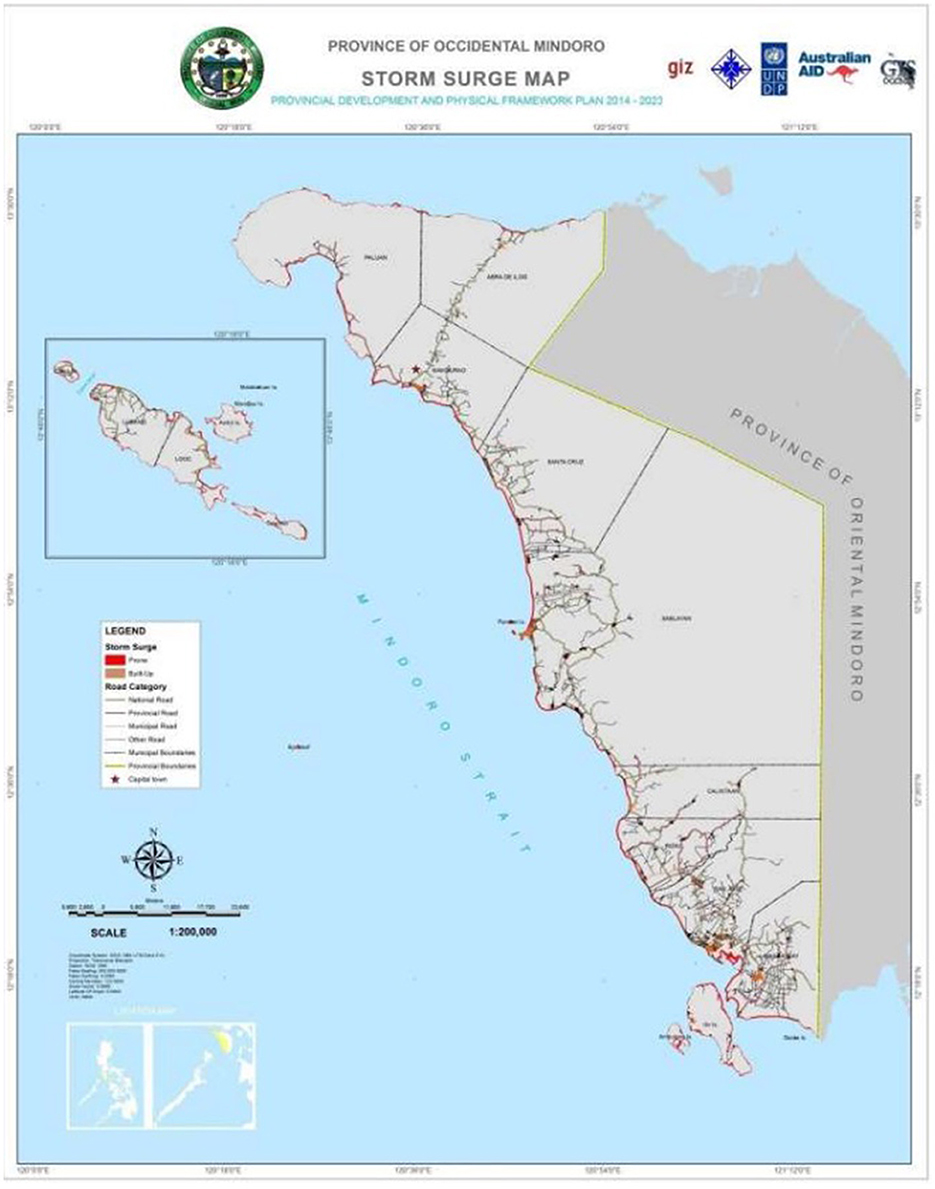
Figure 1. Storm surge susceptibility map of the Province of Occidental Mindoro. Source: Disaster Risk Management Office of Occidental Mindoro 2014–2023.
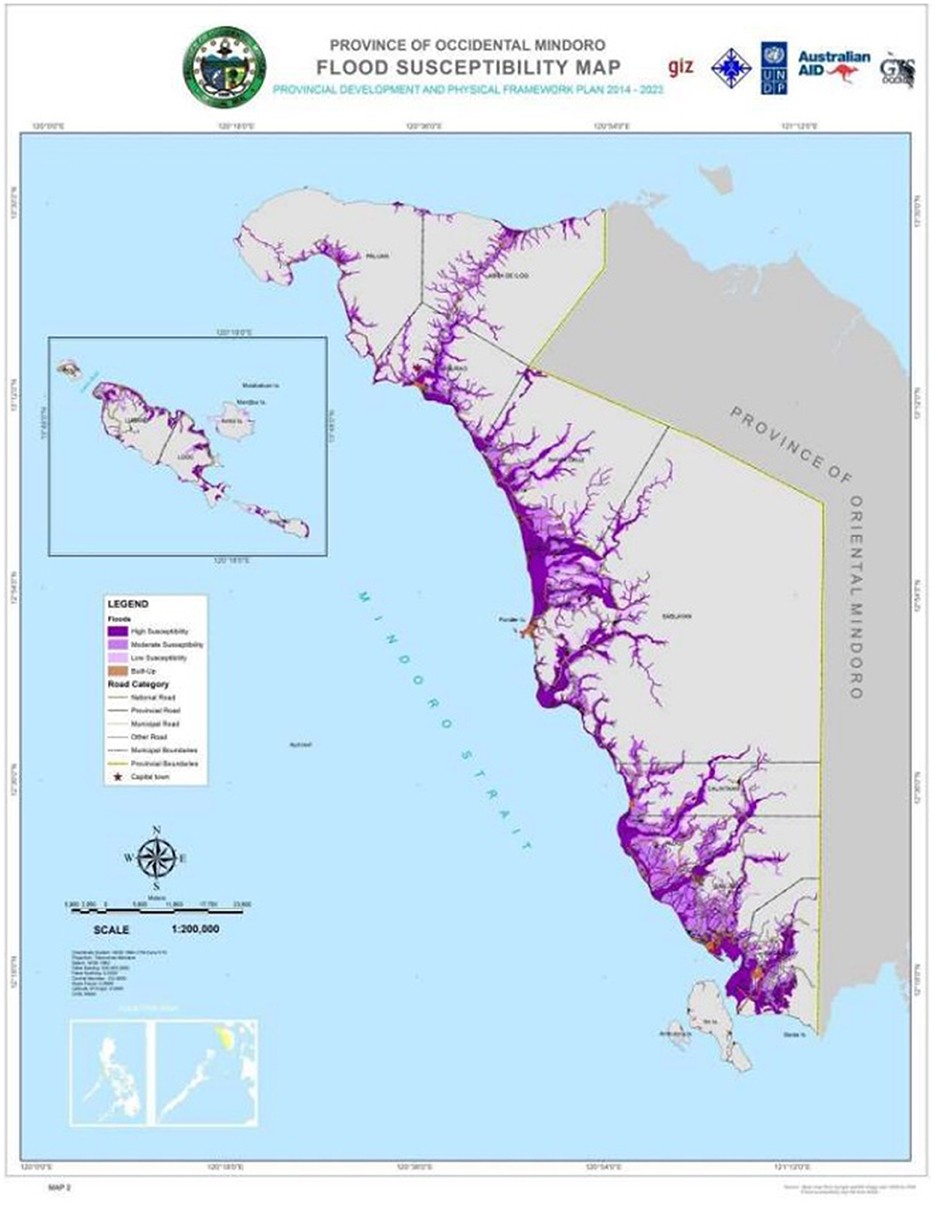
Figure 2. Flood susceptibility map of the Province of Occidental Mindoro. Source: Provincial Disaster Risk Management Office of Occidental Mindoro 2014–2023.
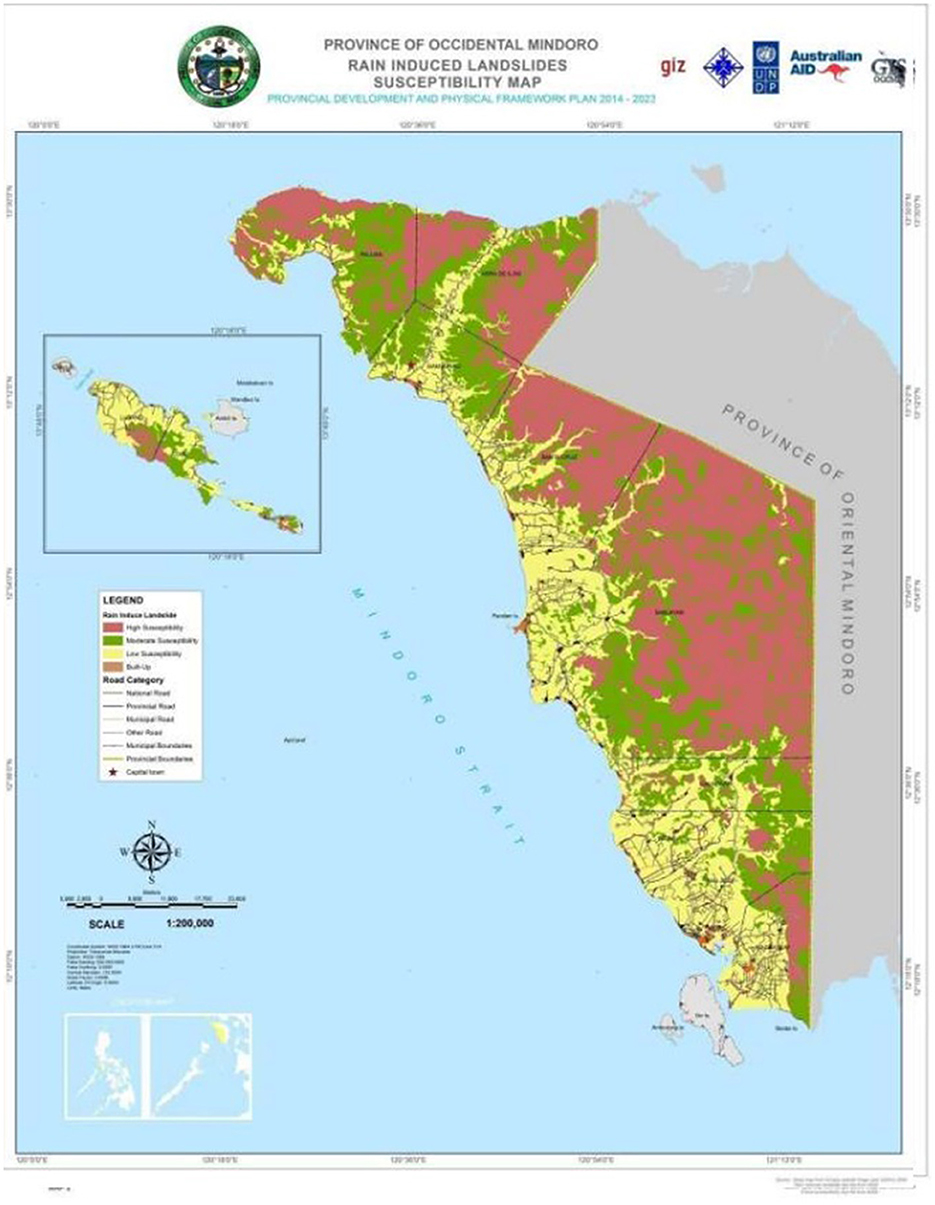
Figure 3. Landslide susceptibility map of the Province of Occidental Mindoro. Source: Provincial Disaster Risk Management Office of Occidental Mindoro 2014–2023.

Figure 4. Mindoro fault lines and trenches map. Source: Provincial Disaster Risk Management Office of Occidental Mindoro 2014–2023.
2.5 Research respondents
The study focused on the 10 Higher Education Institutions of Occidental Mindoro, namely as follows: Occidental Mindoro State College (OMSC) and its six campuses situated throughout different municipalities in the province, namely, campuses of Labangan, San Jose, Murtha, Sablayan, Mamburao, and Lubang Island; the Divine Word College of San Jose (DWCSJ); Philippine Central Islands Colleges (PCIC); Polytechnic University of the Philippines -Sablayan (PUP), and Colegio De San Sebastian (CDSS) (CHED, 2021).
Table 1 shows the list of recognized Higher Education Institutions in the province by the Commission on Higher Education along with their disaster topography. This table depicts the vulnerability and disaster risks that HEIs and their stakeholders may encounter.
Three different sets of respondents, namely, the academic and administrative heads, faculty members/employees, and students, provided the necessary data to be analyzed in answering the research questions. Based on the total number of stakeholders from the 10 HEIs and using the Raosoft Sample Size calculator, 300 respondents were taken as the sample for the study. The sample size was distributed through stratified random sampling for the quantitative data collection.
Out of 300 respondents selected for the quantitative data, 17.6% are aged in the range of 20–29 years, 36% are aged in the range of 30–39 years, 30.8% are aged in the range of 40–49 years, and 15.6% are aged in the range of 50–59 years. The female respondents were 44.8%, while the male respondents were 55.2%. The married respondents were 36%, while the single respondents were 64%. Respondents who have 1–5 years of work experience is 48%, who have 6–10 years of work experience is 12.8%, who have 16–20 years of work experience is 6.4%, who have 25–30 years of work experience is 1.2%, who have 26–30 years of work experience is 3.2%, and those who were full-time students is 28.4%. Some of the students were also working on a part-time basis.
For the qualitative data, the participants consisted of one academic and administrative head, one faculty member, and one student from each respondent set. Notably, 10 HEIs were selected purposively, thus making a total of 30 respondents. For gathering the qualitative data, the researcher personally visited the schools where they were located. Permission and approval were obtained in advance from the school head or campus before the conduct of face-to-face interviews and focused group discussions. Participants were requested to attend and participate in the focused group discussion and if the participant could not attend the focused group discussion due to unavailability and time constraints, then direct interview was conducted individually.
2.6 Research instrument
For the quantitative approach, a researcher-made survey instrument guided and enriched by existing literature and instruments on disaster communication, which were subjected to validation and reliability tests, was used. It was used to gather quantitative data from administrators, faculties, and students. Whereas, for the qualitative approach, a semi-structured interview guide was used. The survey instrument and interview guide were subjected to validation and a pilot study was performed to establish the reliability of the survey instrument.
The survey instrument was designed as follows: Part 1 determined the profile of academic and administrative officials according to sex, age, the highest educational attainment, and position in the Higher Education Institution with the years of service. Likewise, it is set to identify the faculty member's sex, age, the highest educational attainment, department, and the years of service. The profile of students was determined according to their sex, age, year level, and course.
Part 2 determined the communication challenges experienced by stakeholders in Higher Education Institutions during disasters considering individual factors, sociocultural factors, and situational factors using the Likert scale of 4–1 where 4 is a very high extent and 1 is a very low extent.
Part 3 ascertained the disaster communication strategies in the stages of the Crisis Emergency Risk Communication Theory in terms of pre-crisis, initial event, maintenance, resolution, and evaluation using the Likert scale of 4–1 where 4 is a very high level and 1 is a very low level of implementation.
For the qualitative approach, a semi-structured interview guide was used. Thus, in addition to the previously prepared questions, additional and follow-up questions were asked. This was Part 4 of the data-gathering instrument.
Part 4 was an open-ended question using a face-to-face interview directed to gather and analyze the recommendations of the respondents and to include the researcher's insights and lessons learned to improve the disaster communication strategies in their respective Higher Education Institutions.
Before the distribution of the research instrument, permission from the school heads and campus directors was obtained. The researcher personally distributed and collected the research instruments for nearby campuses. The researcher personally answered and responded to the queries of the respondents. The respondents were requested to answer the instrument within 1 week and the responses will be collected thereafter. For the OMSC Lubang Campus which is situated in an island municipality of the province, one of the school officials assisted the researcher in the distribution of the instruments. The questions from the respondents were forwarded to the researcher whose response was immediately provided.
2.7 Mode of analysis
The communication challenges experienced by the stakeholders and disaster communication strategies were measured using descriptive analysis through weighted mean and standard deviation. Factor analysis was used to identify the observed variables that directly affect the latent variables. Regression analysis was also used to determine and measure the effect of communication factors on the disaster communication strategies and Statistical Package for Social Sciences was used for the statistical analysis.
A semi-structured interview guide was used to gather narrative data. After the interview, qualitative data were analyzed using the thematic analysis. Direct Interview with the administrators was carried out personally and interviews with the faculty and students was executed using focused group interviews.
The results of the qualitative and quantitative analyses along with the results from data mining, which was performed by the researcher from the files and records requested to the HEIs and Provincial Government of Occidental Mindoro, were the basis for the formulation of a Disaster Communication Plan for the HEIs of the Province of Occidental Mindoro.
3 Results and discussion
3.1 Communication challenges experienced by HEI stakeholders
The communication challenges experienced by the HEIs' stakeholders in Occidental Mindoro are categorized into three groups, namely individual factors, sociocultural factors, and situational factors (Hansson et al., 2020). These factors are labeled as contributing to communication challenges that the public faces during a disaster and should be managed carefully to ensure a successful communication process. During the communication process, the sending of messages fails because it does not reach the receiver due to communication challenges, which are commonly known as noise interference or communication barriers, that hamper the communication process or at least distort the message (McQuail, 2010).
Table 2 shows that situational factors are perceived as the highest communication challenge experienced by stakeholders. Most of the HEI stakeholders' adversity during a disaster comes from a specific context of a particular disaster such as the disruption of communication channels due to power outages after the storm's devastation and loss of mobile connection occurring at their respective schools.
To elaborate, the highest pressing communication challenge under individual factors was the inefficiency of the emergency relief application text system. Under the socio-cultural factors, confusion and lack of familiarity by the stakeholders with the jargon used in communication updates and warnings were ranked as top communication challenges. Finally, situational factors pressing communication challenges were both loss of internet connection leading to inaccessibility of school social media sites and website and the loss of mobile connection causing an inability to access updates from school administrators and emergency managers.
Overall, communication challenges earned a grand mean rating of 2.56, which is described as high. Situational factors are rated very high with a mean rating of 3.60, while socio-cultural garnered the lowest with a mean rating of 1.84.
3.2 Stakeholders who experienced communication challenges during disasters
The communication challenges experienced during disasters are presented based on the three groups of stakeholders: administrative and academic officials, faculty and employees, and students.
According to the results of the interview, the top communication challenges experienced as shared by the administrative and academic officials during disasters were the affected communication lines hampered by brownouts and slow internet connection intensifying the challenges in the areas of situational factors. Another shared insight that highly contributed to the overall communication challenges encountered by the faculty members and employees was the absence of established communication strategies under a comprehensive disaster communication plan. Furthermore, communication strategies were not formally crafted and written and these are only being created as and when the need arises. Meanwhile, students shared their sentiments toward their experiences of mostly relying on word of mouth, which may be incomplete, altered, or outdated information coming from unreliable resources because of power interruptions and poor lines of communication.
3.3 Communication strategies on CERC phases
The disaster communication strategies are grouped into five stages: crisis and Emergency Risk Communication (CERC) pre-crisis, initial, maintenance, resolution, and evaluation. CERC is a five-stage theory bounded by principles of crisis communication built to assist disasters, crises, and public health emergencies (Reynolds and Seeger, 2005). It was classified as an internationally recognized arsenal of disaster risk reduction. It was widely utilized to target stakeholders to understand and communicate with each other with a set of planning principles that allow them to communicate with a right and timely message to act in any disaster situation (Palenchar, 2010).
In the study, disaster risk communication strategies were the media and approaches that could be used to effectively and efficiently transmit and receive information and also included were the data collected before and during disasters by the stakeholders of HEIs such as the administrators, faculty and employees, and students during disasters such as typhoons, flooding, earthquakes, and fire.
The most frequently applied communication strategy under the pre-crisis phase is the delivery of reports and constructive messages to faculty members/employees and students. It is based on facts provided by the university/college DRRM Office's verified data and not on feelings or public hearsay. Meanwhile, the most frequently applied communication strategy under the initial phase is to report and coordinate under a Memorandum of Agreement (MOA) with the other response and recovery groups and agencies in times of disaster. These are the local disaster departments, police and fire departments, media, and other personnel whose job is to safeguard the public during emergencies, natural disasters, and outbreaks.
In terms of the maintenance phase, motivating school faculty members/employees and students to act or remain vigilant through social media campaigns and advisories using vlogs and education advertisements garnered the highest remark from stakeholders among all communication strategies. For the resolution phase, the most utilized communication strategy is explaining to the university/college website and social media accounts what the institution is doing to respond and recover from the disaster and continue to provide updates to establish the school's credibility. Finally, for the evaluation phase, the widely utilized communication strategy is reducing the public issue and media confusion about the disaster that happened through a designated spokesperson assigned to communicate effectively in disseminating information.
In general, Table 3 shows that among all phases of crisis and emergency risk communication, the maintenance phase received the highest rating from the respondents. This connotes that HEIs in Occidental Mindoro have been consistent and effective with strategies during disasters. They had performed effectively in dealing with uncertainty reduction and continuous communication with the affected groups through messages providing a wider understanding to the public of the situation, intensive support, and cooperation in recovery efforts. In addition, respondents' remarks were high in the evaluation phase. These show that communication strategies revolve toward the evaluation process with a focus on discussions on lessons learned, new understandings, and adequacy of response using evaluation and assessment strategies, documentation of lessons, and creation of new linkages.
Meanwhile, both the initial and pre-crisis phases were deemed by the respondents as the lowest among the five phases. This means that communication strategies during these phases were poor and ineffective. This also means that campaigns being done by HEIs toward disaster education and communication to promote disaster preparedness were poor or lacking. This constitutes unprepared and insufficient disaster management skills among the stakeholders. Moreover, at the onset of the disaster, communication strategies directed toward uncertainty reduction and reassurance using immediate communication to the affected groups, using messages with empathy and alike were also viewed as inadequate and futile.
Overall, communication strategies earned a grand mean of 3.00 described as high with a standard deviation of 0.055 indicating that responses were homogeneous and similar among the different respondents. The maintenance phase had the highest mean of 3.53, which is described as very high followed by the evaluation phase with a mean of 3.41, which is described as high. The strategies that have the least means were the initial phase with a mean of 2.09 and the pre-crisis phase with a mean of 2.69.
3.4 Improving disaster communication strategies
In terms of improving disaster communication strategies, data from the interview of the school officials revealed that the platforms of disaster communication available are limited only to social media, mobile messages, and radio communications which have the potential to be affected by signal and power interruptions during disasters. In addition, faculty and employees observed that there is a lack of emergency hotline service in their respective HEIs and unresponsive social media accounts to reach the institution and relay their situation in times of disasters and emergencies. Meanwhile, students observed that there are few orientations, seminars, and workshops on disaster communication being provided by the HEIs since schools' practices are only limited to drills and training which are not open for all students to attend.
4 Conclusion and recommendations
For the individual factors, HEI's primary method of communication of using mobile phones or text systems has loopholes since the common issue that everyone faces is the loss of communication due to power outages and signal loss because of electrical and cellular post destructions. Meanwhile, for the socio-cultural factors, the writers, editors, and communication managers of HEIs craft materials using jargon that can be too technical and challenging to understand by stakeholders. Finally, the presence and availability of social media accounts and websites of the HEIs can be greatly affected by disasters.
A one-size-fits-all concept does not apply in disaster communication since no single communication strategy or channel can reach all targeted stakeholders effectively during a disaster. Therefore, utilizing various communication strategies aside from social media and mobile messages to reach out to HEI stakeholders is a necessary action. It is recommended that HEIs have to maintain the balance between utilizing the old forms of traditional media such as radio and the new forms of media such as Facebook. This practice helps to address the potential gaps that may arise in either form of media during disasters. Similarly, HEIs should create a disaster communication plan approved by its board of trustees/regents and mobilize a disaster communication team that will execute it along with the cooperation of all stakeholders.
HEIs are greatly affected by technological disruptions in the forms of brownouts and slow internet connection aggravating the challenges brought by disasters since disaster communication strategies are more directed toward new media. This situation keeps worsening as it was discovered that there is no existing disaster communication plan in HEIs in Occidental Mindoro, and the disaster communication teams are not fully operational as HEIs inside the organization. Whereas, policies and orders are only being executed through memos or communication letters and oftentimes not being practiced or executed by their respective institutions since there are no existing disaster communication plans in place. With these aforementioned factors, stakeholders, most especially students, have no option but to rely on the dangers of word of mouth, which may lead to making unwise decisions during critical disaster situations.
From the results provided under the pre-crisis phase, HEIs' capacity to deliver accurate information without being biased or subjective is being practiced. Furthermore, collaboration with partner agencies through a memorandum of agreement to ensure effective response provides additional safety for the stakeholders during the initial phase. In the same manner, to ensure collaborative action against disaster, the motivation of stakeholders to remain vigilant and act wisely using social media campaigns is effective after receiving the highest remarks from stakeholders for the maintenance phase. HEIs as they capitalize on the potential of social media have sustainably informed their stakeholders about the important information on response and recovery during the resolution phase. Finally, the designation of the spokesperson of HEIs during the evaluation phase has reduced the confusion and battled fake news during disasters which helped stakeholders disseminate correct information. These practices mentioned above should be sustainably practiced by HEIs as they are found to be effective by respondents.
In terms of improving disaster communication strategies, officials shared that despite the opportunity social media provides, it could be easily disrupted by signal and power interruptions during disasters. For the Faculty and employees, poor streamlining of stakeholders' concerns was observed with the lack of emergency hotline service in their respective HEIs. Students, on the other hand, have shared sentiments on unresponsive social media accounts that should have been relaying their situation in times of disasters and emergencies.
It is greatly recommended that HEIs invest in traditional media as well to make the information inclusive and establish additional credibility as raised by school officials. For faculty members and employees, the creation of an emergency hotline service is recommended to address the urgent concerns of stakeholders. Meanwhile, the student's recommendation is to create social media management to address the unresponsiveness of HEI's social media page toward the concerns of stakeholders.
5 Safeguard Against Natural Disasters of Academes Through Actions
5.1 Background
Education as a fundamental human right should be ensured by Higher Education Institutions to be accessible, safe, and provided equally. Unfortunately, despite the government support and existing DRRM measures of HEIs in Occidental Mindoro, large-scale destruction brought by disasters hamper educational development in the province. HEIs have been suffering numerous types of disasters ranging from typhoons and flooding to rain-induced landslides (Occidental Mindoro PDPFP, 2014).
Due to the dangers brought by disasters in the HEIs of Occidental Mindoro and the crucial role of disaster communication to ensure effective disaster risk management delivery, the study developed SANDATA or Safeguard Against Natural Disasters of Academes Through Actions. This is a disaster communication plan that is a timely and relevant measure for HEIs to secure an immediate, accurate, streamlined, and clear communication process using disaster communications strategies under all phases of Crisis Emergency Risk Communication.
The results and findings of the study on disaster communication strategies emerged with high remarks by the stakeholders and were utilized as a part of the key communication activities recommended to be used by HEIs in every phase of the disaster. With this, HEIs can fulfill the mandate laid down by the Philippine Disaster Risk Reduction Management Act (RA10121) in safeguarding the community being designated as information generators and strategic communication planners promoting disaster resiliency and securing a safe learning environment for its stakeholders.
SANDATA as a disaster communication plan is divided into nine sections, namely, cover page (Figure 5), introduction, legal basis, scope, audiences, objectives, definition of terms, conceptual model (Figure 6), and disaster communication strategies (Tables 4–8).
5.2 Introduction
The Province of Occidental Mindoro is a disaster-vulnerable community with its development geography facing poverty and climate change and is situated in the western part of Mindoro Island with all of its 11 municipalities situated along the coastlines of the West Philippine Sea. Due to its geographic location, storm surges, strong typhoons, and frequent flooding, it caused damages/losses to lives and properties, education, agriculture, and infrastructure (Provincial Development Plan of Occidental Mindoro, 2014).
Unfortunately, the study of Alejandro (2019) identified disasters to have been hindering educational opportunities and development while Cadag et al. (2017) linked extreme educational hurdles created by disasters resulting in disruptions of class, danger to students' lives, and damages to school infrastructures.
By capitalizing on disaster communication, as suggested by Barrantes et al. (2009), academic institutions can address chaos and confusion and safeguard their stakeholders and can provide visibility, credibility, and concrete direction using disaster communications.
Due to the dangers brought by disasters in the HEIs in the province and the crucial role of disaster communications, the study developed SANDATA or Safeguard Against Natural Disasters of Academes Through Actions, a disaster communication plan for Higher Education Institutions in the Province of Occidental Mindoro.
5.3 Legal basis
This disaster communication plan is congruent with RA 10121 or the Philippine Disaster Risk Reduction and Management Act of 2010 as the primary legal basis of all disaster risk reduction measures of the government. According to Ani et al. (2015), the law directed all national government agencies to institutionalize policies, mechanisms, and programs proactive toward disaster risk reduction provided under the National Disaster Risk Reduction and Management Plan (NDRRMP) for 2011–2028.
5.4 Scope
This plan covers the Higher Education Institutions of Occidental Mindoro, specifically Occidental Mindoro State College and its six campuses situated throughout different municipalities in the province: the campuses of Labangan, San Jose, Murtha, Sablayan, Mamburao, and Lubang Island. The other HEIs include the Divine Word College of San Jose, Philippine Central Islands Colleges, Polytechnic University of the Philippines, and Colegio De San Sebastian.
5.5 Audiences
The involved respondents and sectors for this plan include Higher Education Institution stakeholders, especially college students, faculty members, and employees. The plan also connects with government institutions such as the provincial government of Occidental Mindoro and all the local government units functioning under it.
5.6 Objectives
1. To help all HEI's stakeholders communicate and share information as quickly as possible throughout all phases of disaster.
2. To secure the welfare of the HEIs in the province by managing communication properly in its disaster risk reduction management.
3. To serve as a guide to communicate properly about the prevalent information toward the existing risk and disaster.
4. To ensure an efficient flow of accurate and consistent information during disasters, risks emergencies about the cause, magnitude, uncertainties, and consequences toward the stakeholders.
5. To help communication managers deliver messages through appropriate channels to provide timely awareness and educate the public so that they can understand and implement the preventive measures.
6. To organize and foster cooperation among key internal and external partners.
7. To provide a system of information to the general public through the media and other communication channels to promote informed decision-making.
5.7 Definition of terms
5.7.1 Hazard
A dangerous phenomenon, substance, human activity, or condition that may cause loss of life, injury or other health impacts, property damage, loss of livelihoods and services, social and economic disruption, or environmental damage.
5.7.2 Disaster
A serious disruption of the functioning of a community or a society involving widespread human, material, economic, or environmental losses and impacts, which exceeds the ability of the affected community or society to cope using its resources.
5.7.3 Disaster risk
The potential disaster losses in lives, health status, livelihoods, assets, and services that could occur to a particular community or a society over some specified future time.
5.7.4 Disaster risk reduction
The concept and practice of reducing disaster risks through systematic efforts to analyze and manage the causal factors of disasters, including through reduced exposure to hazards, lessened vulnerability of people and property, wise management of land and the environment, and improved preparedness for adverse events.
5.7.5 Disaster risk reduction management
The systematic process of using administrative directives, organizations, and operational skills and capacities to implement strategies, policies, and improved coping capacities to lessen the adverse impacts of hazards and the possibility of disaster.
5.7.6 Communication strategies
This refers to a range of activities/communication practices that involve talking and listening, writing and reading, performing and witnessing, or, more generally, doing anything that involves “messages” in any medium or situation.
5.7.7 Academic and administrative heads
The designated college officials of a Higher Education Institution supervise all academic and administrative units and colleges of the institution.
5.7.8 Faculty members and employees
A member of the academe who possesses a permanent item that classifies him/her as an academic or administrative member of the institution performing official duties/responsibilities and has been in the service for more than 1 year to experience and witness the disaster risk reduction management practices of the college/university. They should be part of an office/department that is headed by a college/university official.
5.7.9 Students
Officially enrolled as a college student in the current academic year with at least 1 year of residency in the HEI to ensure that he/she has known, experienced, and witnessed the disaster risk reduction management of the college/university.
5.7.10 Higher education institutions
An accredited public institution of higher learning by the Commission on Higher Education either public or private that offers both higher professional education and research-oriented higher education.
5.8 Conceptual communication model
The model is anchored in the Melvin Defleur communication model (Haryanti and Rusfian, 2019), where the communication flow begins at the HEIs in Occidental Mindoro as the primary sources of information in the communication process. Then, as the college/university formulates its disaster messages for its stakeholders, the Crisis and Emergency Risk Communication principles for delivering effective messages have to be observed. As provided by the results of the study, principles, such as urgency, accuracy, credibility, empathy, action, and respect, are necessary for delivering an effective disaster risk message (Miller and Denham, 2020).
The transmitter or the communication medium/channel as one of the most important components of the model has to be carefully selected by the HEIs suited to the capability and availability of their stakeholders (Vardiansyah, 2004). It is a must to consider the communication resources of the stakeholders to ensure the direct transmission of messages from the HEI to its stakeholders which are the college officials, faculty members/employees, and students. Moreover, it is vital as well to determine the best mass medium device/strategy to be utilized for the Crisis and Emergency Risk Communication phases (Sellnow and Seeger, 2013) that the message will be conveyed. Along with this, the HEIs have to be mindful that every phase should have a recommended medium device/strategy in place to avoid the effects of communication challenges or noise, Hansson et al. (2020), which primarily disrupts the communication process or distorts the message causing a failed process of communication, misinformation, or confusion (McQuail, 2010).
The school stakeholders as the message recipients after successfully receiving the message from the communication medium/channel utilized by the HEI have to provide feedback in the form of a message or action as an indicator of successful message delivery in the communication process. The feedback is then expected to be executed again, through the transmitter or the communication medium/channel to relay the message to reach their respective HEIs. Finally, the roles of the primary source of information dissemination and the message recipients should be two-way communication as both HEIs and their stakeholders are expected to send messages and provide feedback and vice versa throughout the communication process.
Figure 6 shows the flow of the communication model under the conceptualized disaster communication plan.
5.9 Disaster Communication Strategies
Communication during disasters is crucial for academic institutions to maintain to protect and empower their stakeholders through accurate and reliable information in the best strategy and medium possible.
To ensure clarity, suitability, and effectivity of disaster communication strategies as an integral component of disaster risk reduction management, the plan provides a list of recommended key communication strategies that can be utilized by Higher Education Institutions in all stages of disaster.
Table 4 shows the pre-crisis phase, Table 5 shows the initial phase, Table 6 shows the maintenance phase, Table 7 shows the resolution phase, and Table 8 shows the evaluation phase. These tables comprised suggested disaster communication strategies in every phase of Crisis Emergency Risk Communication that key stakeholders of Higher Education Institutions in Occidental Mindoro can utilize. Along with corresponding anticipated communication challenges, the suggested medium/channel/transmitter and the office responsible for fulfilling the execution of the communication strategies are provided.
Data availability statement
The original contributions presented in the study are included in the article/supplementary material, further inquiries can be directed to the corresponding author.
Ethics statement
The studies involving humans were approved by UST Graduate School Review Ethics Committee. The studies were conducted in accordance with the local legislation and institutional requirements. The participants provided their written informed consent to participate in this study.
Author contributions
LN: Writing – original draft, Writing – review & editing.
Funding
The author(s) declare that no financial support was received for the research, authorship, and/or publication of this article.
Acknowledgments
The author would like to extend his utmost gratitude to the University of Santo Tomas–Graduate School and all stakeholders of Higher Education Institutions in the Province of Occidental Mindoro from academic/administrative officials, faculty members/employees, to students who participated in the study.
Conflict of interest
The author declares that the research was conducted in the absence of any commercial or financial relationships that could be construed as a potential conflict of interest.
Publisher's note
All claims expressed in this article are solely those of the authors and do not necessarily represent those of their affiliated organizations, or those of the publisher, the editors and the reviewers. Any product that may be evaluated in this article, or claim that may be made by its manufacturer, is not guaranteed or endorsed by the publisher.
References
Academy of Disaster Reduction and Emergency Management (2021). 2020 Global Natural Disaster Assessment Report. Available online at: https://www.preventionweb.net/publication/2020-global-natural-disaster-assessment-report (accessed 7 May, 2022).
Alejandro, R. (2019). National Disaster Risk Reduction and Management Plan (NDRRMP) 2011- 2018, Government of the Philippines, Office of Regional Director, Office of the Civil Defense. Available online at: https://reliefweb.int/report/philippines/national-disaster-risk-reduction-and-management-plan-ndrrmp-2011%E2%80%902028 (accessed 2 May, 2022).
Ani, P., Tidon, A., and Aquino, A. (2015). Republic Act 10121: An Approach in Strengthening Disaster Risk Reduction and Management in the Philippines. Taipei: Food and Fertilizer Technology Center for the Asian and Pacific Region.
Atta-ur, R., and Fang, C. (2019). Appraisal of gaps and challenges in Sendai Framework for Disaster Risk Reduction priority 1 through the lens of science, technology, and innovation. Prog. Disast. Sci. J. 1, 11. doi: 10.1016/j.pdisas.2019.100006
Barrantes, S. A., Rodriguez, M., and Pérez, R. (2009). Information Management and Communication in Emergencies and Disasters - Manual for Disaster Response Teams. Available online at: https://reliefweb.int/report/world/information-management-and-communication-emergencies-and-disasters-manual-disaster (accessed 2 May, 2022).
Bautista, H. (2022). Developing A School-Led Unified Disaster Management Framework for Island Provinces of Region Iv-B: A Mixed Method Approach, Faculty of Graduate School of St. Manila: Paul University Manila.
Boin, A., Hart, P., Stern, E., and Sundelius, B. (2017). The Politics of Crisis Management: Public Leadership Under Pressure. Cambridge: Cambridge University Press.
Bollettino, V., Alycana, T., and Enriquez, T. (2018). Public Perceptions of disaster resilience and preparedness: Evidence from the Philippines. Cambridge: Harvard University, Elsevier.
Cadag, J., Petal, M., Luna, E., Gaillard, J., Pambid, L., and Santos, G. (2017). Hidden disasters: Recurrent flooding impacts on educational continuity in the Philippines. Int. J. Disaster Risk Reduct. 25, 72–81. doi: 10.1016/j.ijdrr.2017.07.016
Cayamanda, K., and Lopez, M. (2018). Community Resilience to Urban Flooding: A Case Study of the 2011 Flashflood in Matina, Davao City, Southern Philippines. International Proceedings of 2018 South East Asia Disaster Risk Governance Academic Seminar. Available online at: https://www.rcrc-resilience-southeastasia.org/wp-content/uploads/2018/10/Paper13.pdf (accessed 20 May, 2022).
CHED (2021). Distribution of Higher Education Institutions by Region and Sector: AY 2019-2020, Commission on Higher Education, Table 2. CHED MIMAROPA website. Available online at: https://ched.gov.ph/wp-content/uploads/Distribution-of-Higher-Education-Institutions-by-Region-and-Sector-AY-2019-20.pdf (accessed 12 April, 2022).
Creswell, J. (2007). Qualitative Inquiry and Research Design: Choosing among Five Approaches (2nd ed.). Thousand Oaks, CA: Sage Publications, Inc. Available online at: https://psycnet.apa.org/record/2006-13099-000 (accessed 23 May, 2022).
Hansson, S., Orru, K., Siibak, A., Back, A., Kruger, M., Gabel, F., and Morsut, C. (2020). Communication-related vulnerability to disasters: a heuristic framework. Int. J. Disast. Risk Reduct. 51, 8. doi: 10.1016/j.ijdrr.2020.101931
Hardiyanto, S., and Pulungan, D. (2019). Effective communication as an effort for natural disaster management in Padangsidimpuan City. J. Interact. 3, 30–39.
Haryanti, S., and Rusfian, E. (2019). Government public relations and social media: bridging the digital divide on people with social welfare problems. JKAP Jurnal Kebijakan dan Administrasi PubliK. 22, 128. doi: 10.22146/jkap.34602
McQuail, D. (2010). McQuail's Mass Communication Theory 6th Ed. London: Sage publications. Available online at: http://www.bou.ac.ir/portal/file/?171392/Mass.Communication.Theory.6th.Edition-(McQuails)-.pdf (accessed 10 April, 2022).
Miller, L., and Denham, M. (2020). Role of institutions of higher education in community-centric risk reduction. eJournal Public Affairs. 15, 3. doi: 10.21768/ejopa.v9i1.5
Neussner, O. (2014). Assessment of Early Warning Efforts in Leyte for Typhoon Haiyan/Yolanda, Deutsche Gesellschaft für Internationale Zusammenarbeit (GIZ) GmbH. Available online at: https://www.preventionweb.net/publication/assessment-early-warning-efforts-leyte-typhoon-haiyan/yolanda (accessed 17 April, 2022).
Occidental Mindoro PDDRMO (2022). Provincial Development Physical Framework Plan 2014–2023. Province of Occidental Mindoro: Provincial Development Office.
Occidental Mindoro PDPFP (2014). Provincial Development Physical Framework Plan 2014- 2023, Province of Occidental Mindoro, Provincial Development Office.
Palenchar, J. (2010). Historical Trends of Risk and Crisis Communication. Routledge, New York: Handbook of Risk and Crisis Communication.
PDRRMO (2014). Provincial Disaster Risk Reduction and Management Plan 2014–2016. Province of Occidental Mindoro: Provincial Development Risk Reduction Management Office, Provincial Government of Occidental Mindoro.
Provincial Development Plan of Occidental Mindoro (2014). Provincial Disaster Risk Reduction Management Office of Occidental Mindoro. Province of Occidental Mindoro: Provincial Government of Occidental Mindoro.
Reynolds, B., and Seeger, M. (2005). Crisis and emergency risk communication as an integrative model. J. Health Communi. 10, 43–55. doi: 10.1080/10810730590904571
Sellnow, T., and Seeger, M. (2013). Theorizing crisis communication, Chichester, West Sussex, England. Malden, MA: Wiley-Blackwell, Available online at: https://ijoc.org/index.php/ijoc/article/download/2923/1150 (accessed 1 May, 2022).
Shepherd, A., Mikaela, A., Faure, R., and Samman, E. (2016). Trends in Poverty and Inequality and Further Clustering of Developing Countries: Challenges and Opportunities for Development Policy- Prepared for the European Commission. Available online at: https://www.chronicpovertynetwork.org/resources/2019/1/2/trends-in-poverty-and-inequality-and-further-clustering-of-developing-countries (accessed 12 April, 2022).
Thomas, T., Kannaley, K., and Spencer, M. (2016). Media Coverage of the 2014 West Virginia Elk River chemical spill: a mixed methods study examining news coverage of a public health disaster. Sage J. Sci. Communi. 38, 574–600, doi: 10.1177/1075547016662656
UNISDR (2015). Making Development Sustainable: The Future of Disaster Risk Management, Global Assessment Report on Disaster Risk Reduction. Geneva, Switzerland: United Nations Office for Disaster Risk Reduction (UNISDR). Available online at: https://www.undrr.org/publication/global-assessment-report-disaster-risk-reduction-2015 (accessed 8 May, 2022).
Vardiansyah, D. (2004). Pengantar Ilmu Komunikasi. Bogor: Ghalia Indonesia. Available online at: https://opac.perpusnas.go.id/DetailOpac.aspx?id=569381 (accessed 15 May, 2022).
Keywords: Crisis Emergency Risk Communication Theory, disaster communications, disaster risk reduction management, Higher Education Institutions, mixed-method research
Citation: Nielo LCG (2024) A disaster communication plan for Higher Education Institutions in the Island Province of Occidental Mindoro, Philippines. Front. Commun. 9:1368221. doi: 10.3389/fcomm.2024.1368221
Received: 10 January 2024; Accepted: 11 March 2024;
Published: 05 April 2024.
Edited by:
Peter Bradl, University of Applied Sciences, Würzburg-Schweinfurt, GermanyReviewed by:
Adriana Zait, Alexandru Ioan Cuza University, RomaniaSteffen Hillebrecht, Technical University of Applied Sciences Würzburg-Schweinfurt, Germany
Copyright © 2024 Nielo. This is an open-access article distributed under the terms of the Creative Commons Attribution License (CC BY). The use, distribution or reproduction in other forums is permitted, provided the original author(s) and the copyright owner(s) are credited and that the original publication in this journal is cited, in accordance with accepted academic practice. No use, distribution or reproduction is permitted which does not comply with these terms.
*Correspondence: Leomar Christian G. Nielo, bGVvbWFybmllbG8xMjNAZ21haWwuY29t
 Leomar Christian G. Nielo
Leomar Christian G. Nielo